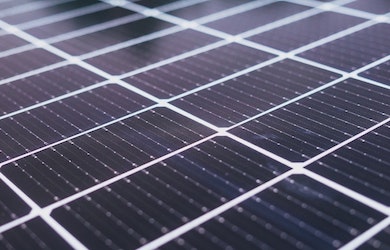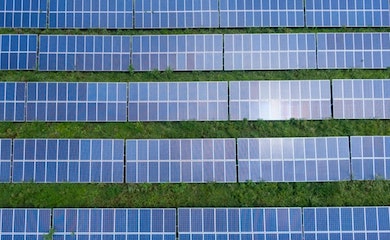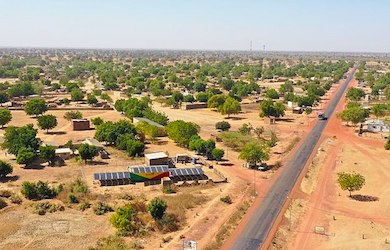Innovative solutions are required to solve the ongoing global climate crisis. Year on year rises to the recorded global average temperature has resulted in a higher frequency of droughts. Water is becoming a precious resource for many communities across the globe. In particular, California (USA) is susceptible to droughts causing wells to dry up [1].
The Water-Energy Nexus and Conservation of Land Resources
Typical solar developments involve ground-mounted solar photovoltaic (PV) panels, and there can be significant use of land resources. In some circumstances, this land could have otherwise been used for agriculture, home building, conservation of wildlife habitats or forests.
Agrivoltaics involves the installation of solar PV developments that combine with agriculture to preserve the available land resource. This solution can involve ground-mounted panels raised to heights more significant than usual to allow growing crops situated around and beneath [2].
The idea behind the water-energy nexus is to conserve water resources and increase renewable energy generation as a combined solution. Floating (FPV) developments (also known as Floatovoltaics) form part of the solution. China has recently constructed a 320MW floating solar development in the Shandong province [3]. Whilst not as well established, solar developments situated above canals also could preserve land and water resources and are of growing interest.
Solar Canals in California
In March of 2021, a study on the solar-canal solution ‘Energy and water co-benefits from covering canals with solar panels’ was published by the University of California [4]. The study concluded that installing solar PV above all of California’s canals (4,000 miles) would save more than 65 billion gallons of water per year due to reduced evaporation caused by shading.
“Most of California’s rain and snow falls north of Sacramento during the winter, while 80 percent of its water use occurs in Southern California, mostly in summer. That’s why canals snake across the state – it’s the largest such system in the world. We estimate that about 1 percent to 2 percent of the water they carry is lost to evaporation under the hot California sun.” [5] – Roger Bales, Sierra Nevada Research Institute, University of California, Merced, CA, USA.
The estimated energy capacity of such a concept would be 13 gigawatts (GW), equal to approximately one-sixth of California’s current installed capacity, and the potential land resources saved is significant.
“That’s enough to irrigate 50,000 acres of farmland or meet the residential water needs of more than 2 million people. By concentrating solar installations on land that is already being used, instead of building them on undeveloped land, this approach would help California meet its sustainable management goals for both water and land resources.” [6] – Roger Bales, Sierra Nevada Research Institute, University of California, Merced, CA, USA.
Furthermore, shading the canals can reduce weeds and algae that need to be removed to prevent blockages. The potential cost savings this would provide have been estimated, “For large, 100-foot-wide canals in California, we estimate that shading canals would save about $40,000 per mile. Statewide, savings could reach $69 million per year.” [7]
Project Nexus and Other Solar-Canal Developments
Recently the Turlock Irrigation District (TID) and Solar Aqua Grid secured a $20million grant to proceed with ‘Project Nexus’, [8] a pilot project that will see the installation of 8,500 feet of solar panels to be built above three sections of TID’s canals.
“The three sections are areas of various orientations and canal widths, ranging from 20 feet wide to 100 feet wide. TID is expected to break ground on the project in fall 2022. Full project completion is expected by the end of 2023.”
The name Project Nexus acts as a reference to the “water-energy nexus paradigm gaining attention among public utilities”. The project is the first solar-canal to be developed in the United States of America and is supported by the findings of the research carried out by the University of California. The aim of the development is to serve as a ‘proof of concept’ such that further solar-canals will be progressed in California in the future.
A research project conducted by a UC Merced graduate student is becoming a reality as the Turlock Irrigation District (@TurlockID) approved piloting the first-in-the-nation construction of solar panels over water canals. https://t.co/G0PzuFxLYW pic.twitter.com/g1zbSApWnM
— UC Merced (@ucmerced) February 9, 2022
Whilst the project is a first of its kind in the United States, there is an existing development in India that supports the concept. In 2012, the ‘Canal Solar Power Project’, a 1MW pilot project along a 750 metre stretch of canal in Gujarat, India, was developed. The success of that project then lead to the first-ever large-scale solar-canal development at the cost of $18.3million [9]. Furthermore, a 100MW solution has been commissioned above canals on the Narmada River and would cover nearly 40km [10].
Despite these successes, not all solar-canal projects proposed have been given the green light thus far. For example, a study carried out by National Renewable Energy Laboratory (NREL) concluded that the proposed 336 mile ‘Central Arizona Project Canal’ project would incur costs that would outweigh the potential benefits.
“Overall, the analyses in this report indicate that the costs outweigh the benefits of placing solar over the CAP canal. One main disadvantage is that a significant structure would be necessary to span the canal to support the panels. Concerns with such support structure include: cost, access restriction to the CAP canal, interference of O&M, limited panel orientation due to the canal positioning as well as the possibility of compromising the integrity of the CAP canal foundation. Covering the CAP canal with PV panels may reduce evaporation because of cooling associated with shading.” [11]
Conclusions
Project Nexus is a solution to the ongoing climate crisis and will hopefully inspire future innovative developments. Research carried out by the University of California outlines the potential benefits that the pilot project seeks to prove. Canals can vary from state to state or country to country, and it remains to be seen if the multi-benefit solar-canal solution will grow in popularity globally in the years to come. There are potential advantages/disadvantages of solar canal solutions which are summarised below.
Advantages:
- Panels remain cooler over water which increases the energy capacity.
- Reduced water evaporation.
- Conservation of land resources and avoids the cost of the land by making use of the existing canal network.
- Lower maintenance costs due to reduction in algae/weed growth resulting in improved water quality and reduced use of herbicides.
Disadvantages:
- Installation of the structure to support solar PV over water is more expensive than on land. A protective zinc layer needs to be applied to the supports to prevent corrosion, and not all canal widths are suitable. [12]
- Potentially not suitable for all stretches of a canal route where panel orientation may not be suitable (e.g. south or east/west facing panels are typical for ground-mounted panels), and the use of panels that track the movement of the sun would not be suitable/possible. [13]
- Canals may be located in rural areas where energy storage/transmission may be prohibitive.
- Potentially increased maintenance costs for repairs to the canal – solar panels would act as a potential obstruction. Furthermore, cleaning dust or waste (birds) to ensure continued panel efficiency could be more difficult due to reduced ease of access compared to ground-mounted panels.
- Canals are spread over large distances, and ensuring security (e.g. graffiti or damage) could be difficult.
About Pager Power
Pager Power undertakes technical assessments for developers of renewable energy projects and tall buildings. For more information about what we do, please get in touch.
References
[1] https://agupubs.onlinelibrary.wiley.com/doi/full/10.1029/2019EF001339
[2] https://cleantechnica.com/2021/03/19/new-solar-farm-piles-even-more-green-onto-green-energy/
[3] https://www.rechargenews.com/energy-transition/smooth-operator-worlds-largest-floating-solar-plant-links-with-wind-and-storage/2-1-1139896
[4] McKuin, B., Zumkehr, A., Ta, J. et al. Energy and water co-benefits from covering canals with solar panels. Nat Sustain 4, 609–617 (2021). https://doi.org/10.1038/s41893-021-00693-8
[5] https://www.smithsonianmag.com/innovation/california-is-about-to-test-its-first-solar-canals-180979637/
[6] https://www.smithsonianmag.com/innovation/california-is-about-to-test-its-first-solar-canals-180979637/
[7] https://www.smithsonianmag.com/innovation/california-is-about-to-test-its-first-solar-canals-180979637/
[8] https://www.tid.org/about-tid/current-projects/project-nexus/
[9] https://www.bbc.com/future/article/20200803-the-solar-canals-revolutionising-indias-renewable-energy
[10] https://www.financialexpress.com/india-news/renewable-future-gujarat-govt-to-set-up-100-mw-solar-power-project-atop-narmada-canal/1494866/
[11] https://www.usbr.gov/main/qoi/docs/09.27.2016%20Placing%20Solar%20Generation%20Structures%20Over%20the%20CAP%20Canal%20final%20.pdf
[12] https://www.bbc.com/future/article/20200803-the-solar-canals-revolutionising-indias-renewable-energy
[13] https://knowyourwaternews.com/why-isnt-the-cap-canal-covered-by-solar-panels/
Jon Evans (May 2015) on wikicommons. Last accessed 16th March 2022. Available at: https://commons.wikimedia.org/wiki/File:Solar-canal_(16746105653).jpg



